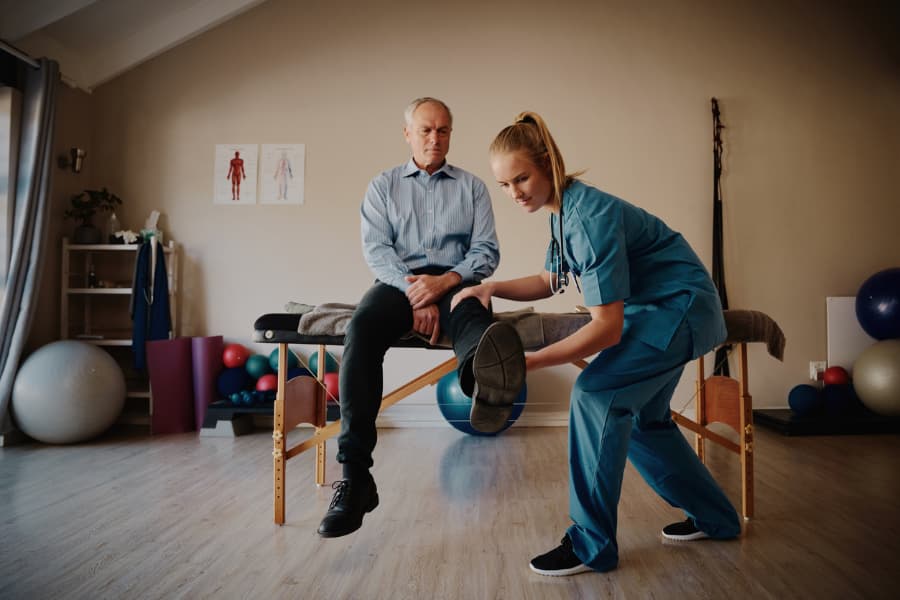Over time, normal wear and tear can damage knee cartilage, leading to pain, stiffness, and inflammation. Many patients can manage knee pain with medication and physical therapy. But for those with significant joint damage, knee replacement surgery may be required. After joint replacement surgery, patients need time to rest, recover, and regain strength and function in their knee. Here, Richmond University Medical Center outlines a typical post-surgery recovery timeline.
Day One After Knee Replacement Surgery
Immediately following knee replacement surgery, patients will be moved to a recovery room within the hospital. The hospital staff will monitor vital signs, and patients may feel drowsy from the anesthesia. Once the patient is stable and alert, they will move to a hospital room. They will receive medication to manage any pain experienced post-surgery. Depending on the surgery’s complexity level and the overall health of the patient, they may stay at the hospital for an additional one to three days before being discharged. However, some patients can go home the same day.
Shortly after surgery, patients meet with a physical therapist who creates a recovery plan. This plan includes exercises and stretches for the patient to do while at the hospital, as well as an exercise routine to follow once they go home. While in the hospital, the care team may use a continuous passive motion (CPM) machine, which mechanically moves the knee while the patient rests. Compression socks also may be used to help reduce swelling.
Upon being discharged from the hospital, some patients are cleared to return home. Other patients are moved to a rehabilitation center. For the first few weeks after surgery, the patient likely will need a walker or a cane to help them move safely. If they work, they will need to take some time off for recovery.
The First Weeks At Home Or In Rehabilitation
The surgical team will provide instructions to follow once the patient leaves the hospital. These will include:
- Wound care: The surgical area should be kept clean and dry. The patient may need to use a water-resistant bandage when showering. Swelling at the surgical site is common, so they also may be instructed to rest, ice their knee on and off, and elevate their leg.
- Pain management: The surgeon likely will prescribe a pain reliever, as well as medication to reduce the likelihood of blood clots or swelling. Patients should take only medications that have been prescribed and follow the dosage instructions carefully, as certain pain medications can increase the chances of bleeding.
- Monitor recovery: Occasionally, surgical wounds can become infected. Patients should notify their physician if they develop a fever or swelling and bleeding at the incision site.
- Eat well: Patients should eat a variety of fruits and vegetables, and drink plenty of water. Constipation is common after surgery, and a balanced diet can help prevent it.
- Home safety: Patients need to protect themselves from tripping or falling while their knee is healing. A family member can help the patient remove any fall hazards from the home, such as throw rugs or electrical cords. If the bedroom is on the second floor, the patient may need to set up a bed on the first floor until they can move up and down the stairs safely.
During the first two weeks after surgery, patients may receive in-home physical therapy. A therapist will help the patient learn exercises that help restore range of motion in the knee and strengthen the muscles, joints, and ligaments. They also usually provide printouts of specific exercises for the patient to do on their own.
Weeks Three To Six After Surgery
After the first couple of weeks of home recovery, patients move to outpatient physical therapy to continue rebuilding strength and function in the knee. The surgeon may not clear the patient to drive for a few more weeks, so they will need to arrange for transportation to and from physical therapy appointments.
Between three to six weeks after surgery, patients often can resume many daily activities such as shopping, cooking, and household chores. Each patient is different, so the medical team may restrict certain activities depending on their progression.
Long-Term Recovery
Once the knee is fully healed, patients can enjoy low-impact exercises such as swimming, hiking, or riding a bike. They should avoid high-impact exercise such as skiing and running. The medical team will help the patient understand their limitations and which types of exercise are recommended. Knee replacements can last for many years, so patients can enjoy a higher quality of life with significantly less joint pain. According to the Cleveland Clinic, most patients who have had a total knee replacement still have good joint function 15 years after surgery.
Learn More About Knee Replacement Surgery
At Richmond University Medical Center, a board-certified team of orthopedic surgeons provides expert joint replacement surgery for patients with persistent knee pain that does not respond to conservative treatment. Richmond University Medical Center serves patients throughout Staten Island, NY, and the surrounding area. To learn more about knee replacement surgery, contact us today.




